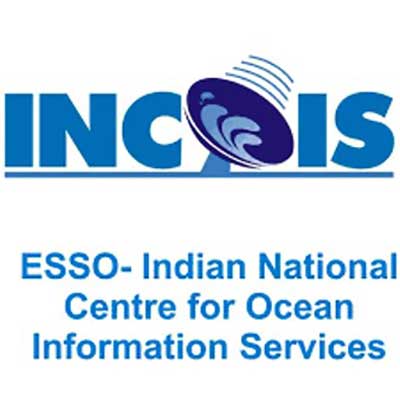Relevance: GS-3: Conservation, environmental pollution and degradation, Disaster and disaster management.
Key phrases: INCOIS, ESSO, tsunami and storm surge early warning, Ministry of Earth Sciences, Coastal Vulnerability Index
Why in News?
- Indian National Centre for Ocean Information Services (INCOIS), with its tsunami and storm surge early warnings, ocean state forecasts, potential fishing zone advisories and ocean data services, has been providing immense socio-economic benefits for a wide range of stakeholders and enhancing the lives and livelihoods of coastal communities.
What is INCOIS?
- Indian National Center for Ocean Information Services (INCOIS) is an autonomous organization of the Government of India, under the Ministry of Earth Sciences, located in Hyderabad.
- ESSO-INCOIS was established as an autonomous body in 1998 under the Ministry of Earth Sciences (MoES) and is a unit of the Earth System Science Organization (ESSO).
- ESSO- INCOIS is mandated to provide the best possible ocean information and advisory services to society, industry, government agencies and the scientific community through sustained ocean observations and constant improvements through systematic and focussed research.
Earth System Science Organisation
Earth System Science Organisation (ESSO) is a virtual organisation set up by Ministry of Earth Sciences GOI in 2007 and it is the executive arm of MoES. It has three major branches of earth sciences viz., Ocean Science & Technology, Atmospheric Science & Technology and Geosciences and Technology.
The overall vision of the ESSO is to excel in knowledge and technology enterprise for the earth system science realm towards socio-economic benefit of the Indian sub-continent and in the Indian Ocean region.
The ESSO contributes to the areas of Weather (General), Weather advisories specific to agriculture, aviation, shipping, sports, etc. Monsoon, Disasters (cyclone, earthquake, tsunami, sea level rise), Living and non-living resources (fishery advisory, poly-metallic nodules, gas hydrates, freshwater etc), Coastal and Marine Ecosystems and Climate Change, Underwater Technology.
What are the services offered by Indian national Centre for Ocean information services?
• Ocean State Forecast: At present, INCOIS provides forecasts of Height, direction and period (of both wind waves and swell waves), Sea surface currents, Sea surface temperature, Mixed Layer Depth (the well mixed upper layer of the sea), Depth of the 20 degree isotherm ( a measure of the depth of the thermocline), Astronomical tides, Wind speed and direction, Oil-spill trajectory.
• Potential Fishing Zone (PFZ): The identification of Potential Fishing Zones was one of the advisory services started by INCOIS. The PFZ uses real-time data for ocean colour and imagery provided by OCEANSAT. This service was started to help fisherman identify high-quantity fishing zones in order to maximise their catch.
• Tsunami Early Warning System (TEWS): In the aftermath of Sumatra earthquake in 2004 and the killer tsunami it set off, the Government of India wanted to set up an early warning centre for tsunami and other storm surges in the Indian Ocean region. Accordingly, on 15 October 2007, a centre housing the Indian Tsunami Early Warning System (TEWS) was established in INCOIS by the Ministry of Earth Sciences, the nodal ministry, with the collaboration of the Department of Science and Technology (DST), Department of Space (DOS.
• The data obtained from a network of equipment is used to run models to provide maps that describe inundation scenarios for the entire coastal belt. Based on these scenarios, potential danger zones ate identified to generate advisories for various stakeholders. In the event of a Tsunami, advisories are generated at intervals that show the location of storm surges which helps local authorities to evacuate people from the region likely to be affected.
• Indian National Centre for Ocean Information Services (INCOIS), with its tsunami and storm surge early warnings, ocean state forecasts, potential fishing zone advisories and ocean data services, has been providing immense socio-economic benefits for a wide range of stakeholders and enhancing the lives and livelihoods of coastal communities.
• Indian National Centre for Ocean Information Services (INCOIS) has published an atlas of Coastal Vulnerability Index maps the entire coastline of India using data on sea level rise, coastal slope, shoreline change rate, coastal elevation, coastal geomorphology, tidal range, and significant wave height.
Coastal Vulnerability Index
Indian National Centre for Ocean Information Services (INCOIS) has published an atlas of Coastal Vulnerability Index maps the entire coastline of India at 1:100000 scale using data on sea level rise, coastal slope, shoreline change rate, coastal elevation, coastal geomorphology, tidal range, and significant wave height.
According to the studies conducted, as many as 124 km of coastal stretch recorded under very high coastal vulnerability which was 5.36 per cent of the total coastline of the state.
In Tamil Nadu, 65 km of coastline, which is 6.38 per cent of the total coastline of the state ranks very high on CVI, followed by West Bengal (49 km, 2.56 pe cent), Karnataka & Goa (48 km, 9.54 per cent), Odisha (37 km, 7.51 per cent), Andaman Islands (24 km, 0.96 per cent), Kerala (15 km, 2.39 per cent), Nicobar Islands (8 km, 0.97 per cent) and Andhra Pradesh (6 km, 0.55 per cent).
Source: The Hindu
Mains Question:
Q. Discuss the role of Indian National Center for Ocean Information (INCOIS) in providing immense socio-economic benefits for a wide range of stakeholders and enhancing the lives and livelihoods of coastal communities. Critically examine with example.









